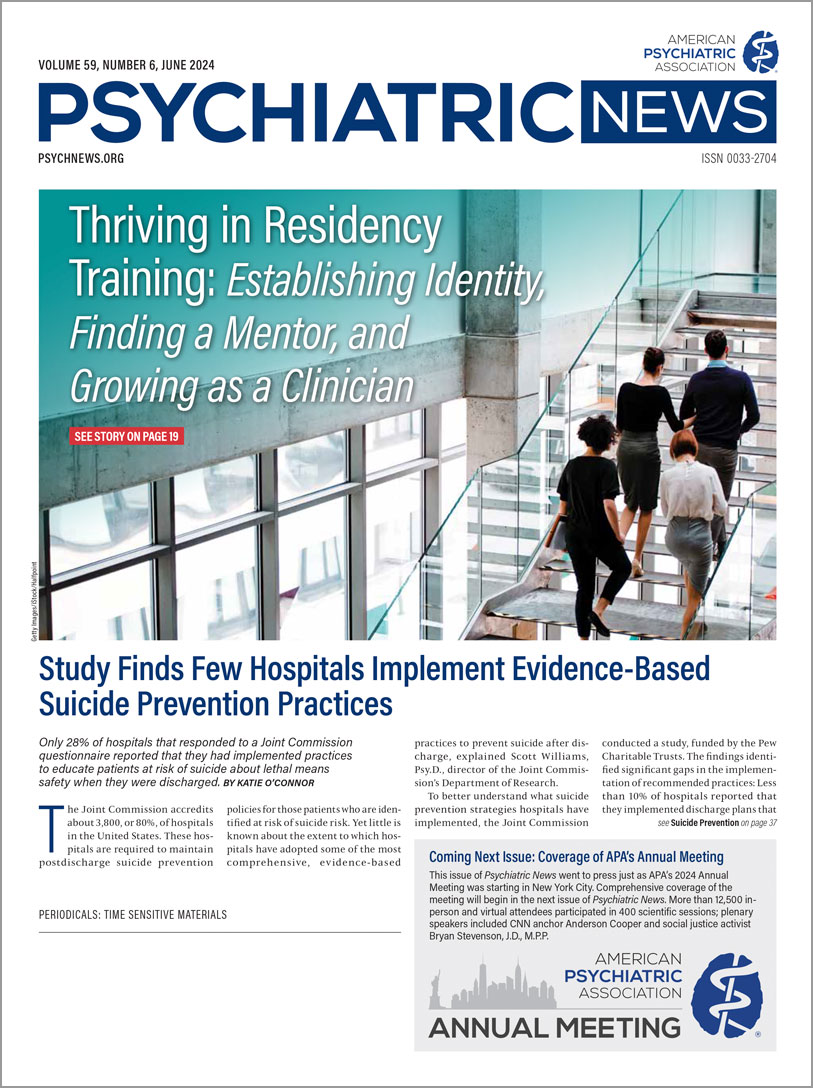Artificial intelligence (AI) is already powering a number of commercial mental health apps, such as chatbots that aim to “talk” people through their problems or wearables that sense users’ stress and prompt them to breathe or meditate.
Clinicians and researchers, too, have begun exploring and embracing the benefits of AI tools like machine learning to streamline their jobs and improve patient care. Psychiatric News spoke with several organizations to find out how they’re using AI to speed completion of session notes and improve use of evidence-based psychotherapy, track sleep duration and medication response for hospitalized patients, and even make discharge summaries more patient friendly.
AI Generates Notes, Aids in Training
Guadenzia, a nonprofit substance use disorder treatment center, turned to AI nearly three years ago to help improve efficiency and ease the burden on staff during the pandemic, explained Andrew Schmitt, L.C.S.W., outpatient director. Their AI system listens in on clinical sessions and automatically generates a draft progress note at each session’s end. “That way we’re not starting from a blank sheet of paper. ... It allows me to edit or adjust a note, too, so it really becomes a richer, more robust document with less brain power expended.”
The AI system serves as a training and development tool, too, tracking clinicians’ use of evidence-based interventions. The system’s playback feature “allows supervisors to do direct observations of clinicians without having to be physically present in the room,” Schmitt said. In fact, the AI system directs supervisors to play back key moments in a recording that it deems have the potential for clinician development, he said. “We’re seeing clinicians use it for their own insight as well.”
Staff’s use of evidence-based interventions has increased 35% since implementing the system, Schmitt added. Offering this resource for staff has been a great boon to recruitment and has lowered staff attrition.
Darren A. Dunham is a team leader at Trilogy Inc., a nonprofit mental health provider serving marginalized populations in Chicago. He said that his organization’s use of AI-generated notes has reduced the time he spends writing a high quality note from around 12-15 minutes to as little as two minutes.
“That allows us to spend more time with [patients] and do the work that drives us to be in this field in the first place,” Dunham said.
AI Transforms Discharge Summaries
The 21st Century Cures Act mandates that physicians, hospitals, and other providers give patients prompt access to the information to their electronic health records (EHRs), including patient histories, progress notes, and discharge summaries.
“In my opinion, giving patients access to their records is a huge benefit to patients and caregivers, and ultimately will lead to improved health outcomes,” said Jonah Zaretsky, M.D., a clinical assistant professor and hospitalist in the Division of Hospital Medicine at New York University Langone Health. However, information in the EHR that patients cannot read because of technical jargon or mysterious abbreviations misses the mark.
So Zaretsky and colleagues spent six weeks developing and refining a large language model that aimed to transform hospital patient discharge summaries, according to their recent
report published by
JAMA Network Open. Their goal: to create a summary that was just one page long and readable at a sixth-grade level.
AI in healthcare is often developed from the point of view of medical professionals and their role in the process, Zaretsky said. “I wanted to turn this around and ask from a patient perspective, ‘How can we improve healthcare delivery?’ ” The AI-enhanced summaries were significantly shorter on average, about 350 words versus 1,500. The summaries were also successfully reduced to a sixth- to seventh-grade reading level, on average, from an 11th-grade level.
As for understandability, the AI-enhanced summaries scored 81% on a standard understandability tool, the Patient Education Materials Assessment Tool, compared with just 13% for the original summaries.
Accuracy proved the biggest challenge: Two physicians reviewed each patient-friendly discharge summary for accuracy, and only about half of the summaries (54%) earned the highest possible rating. Further, nearly 20% of the reviews contained safety concerns, mostly involving omissions in important information. There were also several convincing yet inaccurate reports, termed “hallucinations.”
Despite the safety hurdles, Zaretsky said that their generative AI prompt shows promise in making patient information more accessible to patients themselves. “Initial implementation will require robust clinical safeguards such as physician review before publishing the output to patients,” the authors concluded.
AI Tracks Inpatient Sleep and Activity
Some patients admitted into McLean Hospital, a Harvard-affiliated psychiatric facility in Massachusetts, are fitted with a watch-like device that can offer clinicians a trove of information.
The wrist devices patients wear use actigraphy to capture data about their sleep and movement during their stay, explained Justin Baker, M.D., Ph.D., an associate professor of psychiatry at Harvard Medical School and co-director of the Institute for Technology in Psychiatry at McLean Hospital. Specialized algorithms estimate patients’ sleep quality, fragmentation, and duration, as well as their total amount of activity each day.
Prior to using the watches, staff would look in on patients’ rooms five times a night and manually record whether or not the patients were asleep. However, sleep can be hard to assess from across the room, and patients’ self-reported insomnia wouldn’t always jibe with staff records, Baker said. “Information about patients’ sleep was something we needed more fidelity on. ... Adding a watch seemed very similar to the hospital bracelet they were already wearing.”
The data on sleep and activity are paired with important clinical events pulled from the patients’ EHRs, such as changes in medication or dosing, as well as mental status. The idea is to help clinicians understand precisely what impact a given treatment is having to ultimately improve care, he explained.
The reports are illustrated with complex graphics as well as a short radiology-style text summary that allows staff to quickly read it and understand, Baker said. “Having that objective data can help us see how a patient’s condition has changed over time, which is particularly helpful when people have been hospitalized for weeks or months.” The program started out as a research study, but because it has shown promise, it is being piloted as a clinical quality improvement effort on two of the hospital’s units.
Staff are encouraged to share the data with patients, so they understand what information is collected, how it is used, and how much their metrics have improved since their admission. What do patients think about the program? “By and large, patients understand that this is part of their treatment, and we don’t have many people declining to participate,” Baker said. Staff members are given a script to help answer any patient questions that arise, such as whether the watches have a GPS tracker (they don’t).
Researchers at McLean are still trying to figure out how to best utilize the actigraphy information. “We believe that physicians should be using more measurements. ... Right now, we’re trying to figure out how to get [the sleep and activity data] into their workflow but use the least amount of their time.” One possibility under consideration is to build the sleep and activity information in the EHR. ■

